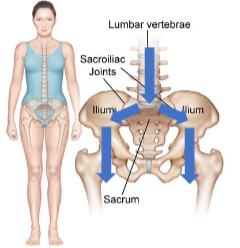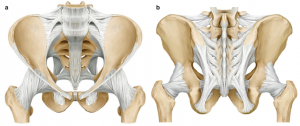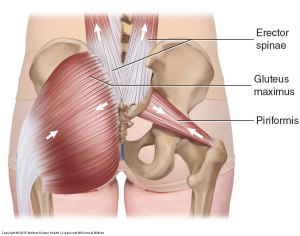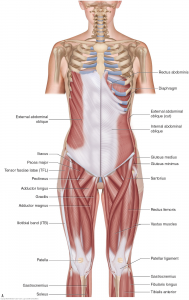The Sacroiliac joint (SIJ) is a synovial joint which joins the base of your spine (sacrum) to the 2 sides of your pelvis (ilium). If you have ever looked closely at a skeleton, you will notice that the joint is comprised of a wedge shape (the sacrum) lodged between the two pelvic bones.

What does the SIJ do?
The SIJ functions to transfer the weight of your upper body (approximately 60% of your body weight) from your vertebral column across into your legs as you walk, skip, jump and run. Due to the high loads being transferred through this joint, it needs to be very strong and stable. But given its unusual shape, how does the SIJ manage to resist such large forces?

Closer observation of the joint reveals part of the answer – along the bones are a series of bumps and ridges that fit into each other like a jigsaw puzzle to provide some stability, and, like all other joints, the SIJ is surrounded by numerous very strong ligaments that cross the joint and provide further support. However, this alone is not enough to support the joint – and that’s where muscles come in.

There are a total of 35 muscles that assist around the SIJ – some work to shift loads onto different areas, while others work to stabilize the SIJ itself.
Muscles that transfer load into our limbs include:
- Gluteus maximus
- Lumbar erector spinae
- Piriformis
- Iliacus


Then we have muscles that transfer weight to other areas of the pelvis such as:
- Quadratus lumborum

- Gluteus minimus and medius
- Rectus femoris
- Tensor Fascia Latta
- Abductors
- Rectus abdominus
Our stabilizing muscles then attach to the support ligaments around the SIJ, stabilizing the joint by tensioning the ligaments when they contract, and include:
- The pelvic floor
- Transverse abdominus, with attachments of internal and external oblique
- Multifidus
- Gluteus medius and maximus
- Hamstrings
- Thoracolumbar fascia, with attachments of trapezius and latissimus dorsi.


So, what can go wrong?
Our bodies are not fool proof! SIJ dysfunction occurs when these supporting muscles and ligaments fail to stabilize the region, leading to irritation and inflammation at the joint. So, despite all this support, we can still get pain from SIJ dysfunction – it has been found to be the cause of 30% of recurrent low back pain.
Some common causes of SIJ dysfunction include:
- Pregnancy and childbirth
- Trips and falls – especially if landing on buttocks
- Trauma (e.g. car accidents)
- Excessive running on hard surfaces – especially if there is insufficient muscle support
- Kicking sports
- Contact sports
- Deep core and pelvic floor dysfunction
Do I have SIJ dysfunction?
Typically, SIJ dysfunction presents as pain on weight bearing. Aggravating activities include:
- Prolonged standing, sitting, walking, running
- Standing on one leg (e.g. putting on pants)
- Rolling in bed
- Getting in and out of the car
- Bending forwards or arching backwards
Symptoms that may be present are:
- Low back or buttock pain
- Radiating pain down leg or into pelvis
- Increased frequency and urgency of bladder
- Inhibition of primary pelvic and low back stabilizing muscles including the pelvic floor, transverse abdominus (and obliques), multifidus, and Gluteus maximus, medius, and minimus.
- Spasm of muscles including piriformis, lumbar erector spinae, hamstrings, hip flexors, adductors and TFL
- This can then present as groin pain, tight back and hamstrings, lateral hip pain, or pain on the inside or outside of the knee.
What is the management for SIJ dysfunction?
Treatment of SIJ dysfunction involves a thorough assessment and treatment planning. The aims of treatment are to address the dysfunction by a combination of manual therapy and specific exercises. If you think that your low back pain might be coming from SIJ dysfunction, please book in with one of our Physiotherapists to get an assessment and treatment plan.

